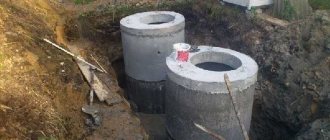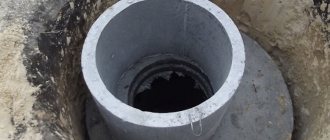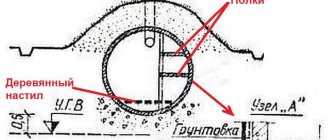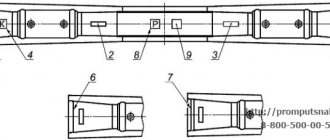R.L. Dregval asks a question:
Two years ago I dug a well at my summer cottage, the water was clean and tasty. Summer residents from neighboring streets came to take water. This summer I discovered that the water was a little cloudy and the top rings were slightly shifted. Why did this happen and how are the well rings aligned?
Our expert answers this question:
There are few reasons for this, but they exist. The displacement of the mine elements is caused by natural factors, namely:
- Soil swelling.
- The emergence of quicksand.
Installation of a cesspool made of concrete rings
You need to start arranging a cesspool with a project. At this stage, you need to determine the depth and diameter of the future tank, as well as choose the right location that meets sanitary standards.
Sanitary standards for the construction of cesspools
If the soil on your site is sandy and non-heaving, then you can use a well without a bottom, but the following requirements must be taken into account:
- The minimum distance from the cesspool to the house must be at least 5 meters;
- The distance to the road must also be at least 5 meters;
- The distance from the source of drinking water must be at least 50 meters;
- The distance from a standing body of water must be at least 30 meters;
- The distance from a river or stream must be at least 10 meters.
It is also necessary not to forget about the convenience of sewerage maintenance. Standard sewer trucks have a hose length of within 3 meters, so it is necessary to ensure unhindered access of the machine to the cesspool. The depth of the pit must also be selected based on these considerations.
In addition to the above, when using a pit without a bottom, its lower edge must be at least 1 meter above the groundwater level, otherwise there will be a risk of flooding of the cesspool and its ineffectiveness.
You can find out the depth of groundwater from your neighbors, or by contacting a special organization that conducts geological surveys.
Selecting the volume of the cesspool
To select the volume of the cesspool, the daily water consumption of all residents of the house is taken into account. As a rule, for houses with year-round use this figure is 150-200 liters. This volume includes the use of a toilet, shower, washing machine and other devices. For cottages and houses with seasonal residence, this figure will be lower.
By multiplying the daily water consumption of one person by the number of residents in the house, we obtain the total daily consumption and, accordingly, the estimated amount of waste water. For a standard family of 3 people, the weekly waste volume is about 3 cubic meters.
3 cubic meters is the minimum required volume of a cesspool, which is calculated from the bottom to the pipe through which wastewater enters the pit. Based on the required size, a location on the site is selected.
A system of several cesspools is often used to increase the volume of wastewater and save money on pumping. This approach is justified if there are sewer trucks of appropriate capacity in your area of residence.
Selection of concrete rings for a cesspool
Having calculated the required volume of the cesspool, they proceed to the selection and purchase of concrete rings. The range of rings is wide and allows you to assemble the desired design with the required volume.
As a rule, the height of standard concrete rings is 1-1.5 meters, and the diameter is 1-2 meters. By varying the size of the rings, it is possible, for example, to select wide rings for areas with high groundwater levels, reducing the height of the sewer system. Or, on the contrary, use narrow rings if you are limited in space. Thus, you can choose any configuration of a sewer well for the required volume and terrain features.
Manufacturers are adapting to the market, so you can purchase a complete cesspool installation kit in one place. The range includes such items as:
- Ring with bottom
- Standard rings that are connected to each other with a locking connection.
- Narrowed necks with floor slabs and holes for hatches.
Also, if the project provides for a pit without a bottom, it is possible to purchase perforated rings, which provide for better drainage of wastewater into the ground.
Digging a pit for rings
There are two ways to dig a pit for a cesspool - manually or using an excavator. Manual digging of a pit is a labor-intensive and time-consuming task, but it allows you to make a neat hole exactly to the size of the rings, which is important for most small areas.
Digging with an excavator is faster, more expensive, and allows you to form a pit that is larger in size than the size of the future cesspool. This may be relevant for cases when the outer surface of the well is waterproofed, or a system of several wells is made.
The depth of the pit is selected based on the estimated number of rings selected in accordance with the planned volume of wastewater. This height will be measured down from the filler pipe, which is laid below the freezing depth of the soil, which is approximately 1-1.5 meters. Often such a pipe is additionally insulated, or a heating cable is laid inside it if it is not possible to deepen it to the required level.
Thus, wide rings are not installed above the filler pipe in the sump pit, because this increases the cost of purchasing wide rings, and a narrow neck is installed, which allows for pumping out wastewater and does not take up much space on the surface of the earth.
Digging a trench for a sewer pipe, as well as laying the pipe itself, is also performed at this stage.
Installation of concrete rings
Installation of concrete rings in the pit is carried out using special equipment, this makes the work easier and avoids breakage of the rings. To begin with, a compacted sand cushion 20-30 cm thick is formed at the bottom of the trench, which is leveled.
If a sealed factory concrete bottom is provided for the cesspool, then it is first lowered into the trench. Next, the first ring is lowered into the groove of this concrete bottom, and their joint is sealed with a special cement-based compound.
The operation of joining the bottom and the first concrete ring can also be carried out on the surface of the earth, waiting for the sealing solution to harden. In this case, you need to pay special attention to leveling the bottom of the pit, since leveling the bottom with the ring will be more difficult.
In addition to the factory bottom, the first ring can be installed on a concrete or reinforced concrete base specially poured at the bottom of the pit. With this installation method, it is necessary to carefully level the concrete layer until a completely flat surface is obtained.
Then, by analogy, the grooves of all subsequent rings are sealed, and the entire cesspool is assembled according to the principle of the designer. A hole is punched in the last wide ring for the filler pipe, which is also sealed after the pipe is installed.
Next, a floor slab with a hole for mounting a neck with a hatch, as well as a hole of a smaller diameter for a ventilation pipe, is installed on the rings.
If sealing the sewer well is not planned, then instead of a concrete bottom, a filter backfill is used according to the principle of a filtration well. This backfill retains solid particles and allows liquid to enter the soil, preventing it from silting. Typically, the cushion consists of a layer of coarse river sand, a layer of fine crushed stone and a layer of coarse crushed stone at the very top. The thickness of such a filter layer should be from 40-60cm to 1 meter for proper operation. Only after filling the filter layer do they begin to install the rings.
The downside of the filter bed is that after some time it will become unusable and will no longer allow waste to pass through it. In this case, it will have to be replaced.
As a means for sealing joints, modern cement-based compounds are used with the addition of special plasticizers, which give the composition waterproofing properties and prevent destruction.
It is impossible to use ordinary cement masonry mortar for these purposes, since when the soil moves and the rings are deformed, such a mortar will crack and the cesspool will lose its tightness.
If it is important for you to achieve complete tightness of the cesspool on your site and avoid capillary suction of wastewater through the concrete, it is necessary to carry out external waterproofing of the concrete rings with roll or bitumen materials.
Final work
The final stage of constructing a cesspool will be backfilling the pit and installing a hatch. For a long time, the most common hatches were considered to be those made of cast iron, but in the last decade, options made of plastic or other composite materials have become widespread. Such elements are much cheaper and easier to install.
It is important to remember that after backfilling a pit, the soil settles after some time, so when backfilling it is necessary to leave some of the soil on the site in order to subsequently fill the resulting voids.
After complete settlement of the soil, the hatch and ventilation pipe are either left as is or decorated. Options for decorating sewer manholes are presented below:
Soil heaving
The fact is that when spring comes, the soil begins to thaw and groundwater actively moves inside the rocks. The pressure on the barrel walls increases, which often leads to rupture of the seams of the upper elements. If you look closely, you can notice these irregularities.
Groundwater along with the soil seeps into the structure and silts up the bottom, which leads to cloudiness of the water. Closer to summer, active processes calm down, and the rings try to return to their previous position. As a result, their movement occurs.
Do-it-yourself well. Lowering the rings
Building a well with your own hands is not as difficult as it might seem at first. In order to equip a well, you will need: construction equipment (a shovel and a drainage pump) and materials for building a well (rings, a lid and stones). Our article, which describes important recommendations for building a well with your own hands, can help with other nuances.
To begin with, it is important to understand what kind of well we need: a water intake well or a well-well. Then you need to outline how deep the future well will be; this will directly depend on the chosen location and what the layer of water will be in it. After we have decided on the depth, we decide on the type of rings for the well and their number.
It is possible to dig a well yourself, but the best option would be to have 3-4 people. From the inventory we will need: shovels, large metal buckets, a pump for pumping out water with a hose and an extension cord, a device for immersing rings and special clothing (high boots and gloves), as well as a tape measure, a ladder and a flashlight (the most convenient one is attached to the head). In addition to this, we will need: rings for the well, a lid, a hatch and stones.
Recommendations for constructing a well:
- The first step is to cut the shovel handle so that it is slightly larger than the outer diameter of the well ring. While digging, you will need to turn the shovel in a horizontal direction, thereby determining the radius of the future well. In the place where the shovel will get stuck, dig up the ground. It is also worth taking note that it is better to use a shovel, which has a removable handle at the end of the handle, with which it will be much more convenient to drip.
- Try to match the diameter of the well to the diameter of the rings. If you make the hole larger, the rings will not take a clear position and will move, which in the future can lead to soil falling into the well.
- To construct a well, at least two people are required, while the first one digs a hole, the other pulls a bucket with a rope and pours the excavated soil from the well.
- When digging a hole, it is important to maintain the verticality of the walls of the well. Otherwise, it will be difficult to install the rings, since the dug hole may turn out to be crooked.
Various variations of immersing rings in a well
Rings can be loaded manually or using special equipment. It is possible to manually dig a hole for a well and then immerse the rings in it. The most important thing here is that the hole is dug smoothly and the rings do not get stuck in it. If this happens, you need to dig up the ground in places where the ring does not pass, this will solve the problem, and subsequent rings will pass even faster. The downside in this case is that there is a possibility that the well cylinder will not be perpendicular to the ground. Also, when lowering the rings manually, they may warp due to the fact that they are lowered unevenly. To avoid this, use another option for lowering the rings. To do this, you need to dig a hole under one ring and immediately lower it into the ground. Then dig out the ground for the next rings, etc. When lowering the rings individually, it is more difficult to dig a hole, but with this method the rings do not warp, but lie evenly on top of each other. This option, in addition, also requires less physical strength, since the rings need to be immersed to a small height.
Using special equipment to lower the rings into the well will be much more expensive, since the work of a crane or tractor will not be cheap. The most economical option may be using a manipulator. If you use large rings for a well, they must be transported to the work site; this cannot be done with a regular machine. If you use the services of a manipulator to deliver rings, you can immediately unload the rings from its body into a dug hole for a well.
Next, we will look at options for devices that can simplify loading the rings into the well. Fully manual immersion of the rings is very inconvenient, since when tying them to a rope and gradually lowering them, the rings can begin to loosen greatly to the sides. You can make several attachment points to make the ring lower more evenly, but it is best to use special devices.
To simplify the process of immersing the rings, as well as to lower them evenly and smoothly, it is possible to use special devices. They are different, but they all have the same purpose.
Professionals in this business usually use welded fixtures with a collar. This is a very reliable mechanism, thanks to which, in addition to its direct purpose, it is also possible to lower and raise heavy buckets of soil and the workers themselves from the well pit.
For non-professionals, there are also more simplified devices that can be easily made with your own hands. You need to place a tripod over the well. You can make such a structure from wooden whips; they need to be installed in a cone and tied at the top. Their length should be approximately 3-4 meters and diameter 5-10 centimeters. Wooden rods can be replaced with beams or boards, previously nailed together. A winch or a special block with a rope and hook is tied to the top of the structure. The rope is put into the block in two turns so that it does not rub against itself.
Lowering the rings into the well pit
The rings should be placed next to the pit, as close as possible to the future well. Difficulty may arise if there are large rings; small rings with a diameter of up to 1.5 meters and a wall depth of about 5 centimeters can be rolled up manually. But, if you use rings up to 10 centimeters thick, it will not be easy to handle them manually. You can install them on metal pipes and try to move them using a winch. With this method of traction, you can even move heavy rings alone, but with a lot of effort. If such a design is not available, you can use the old method and try to move the rings using a crowbar.
After moving the rings to the well pit, you need to carefully attach them to the made tripod using a winch or a block with a hook, depending on the design of your tripod. After this, the rings are carefully and slowly lowered down. Since the weight of the rings is very significant, the rope must be thick and strong.
Other methods of immersing rings in a well
There is also a more extreme method of lowering rings into a hole. Basically, this method was used before; the rings were simply thrown into the well pit and aligned below, in the pit itself. At the same time, boards are installed at the entire height of the well, which are needed so that when the rings fall, they do not get stuck and damage the walls of the dug hole. Then you need to move the rings to the desired location. The rings are moved around the corner and installed smoothly using a pry bar or using a structure made of a log and a rope attached to it, which is attached to the edge of the ring itself. The most important thing in this procedure will be to install the rings so that they sit exactly on top of each other. Boards can be placed on the lowered ring, which are then removed, in order to avoid damage to the lower ring when the next one is immersed.
For better adhesion of the rings, you can lubricate them with a special cement solution; this is also done so that if soil gets in, the rings do not burst apart.
To simplify the task, you can make a slight tilt to make the ring roll easier. There are many options for making it easier, more convenient and safer to lower the rings into the well pit. You choose which of the above methods is suitable in your case.
In conclusion, it can be noted that it is possible to install a well on your own, without resorting to the help of professionals and special equipment. The main thing is to use the recommendations and instructions on the technology for constructing a well, and do not forget about safety precautions. One of the most difficult and traumatic moments in installing a well is immersing rings in it. We paid maximum attention to this point in our article. With all the above knowledge, you should be able to cope with this task.
Would you like to learn more about our well construction services (their prices, as well as the terms and conditions for their provision) or use them today?
Then call without delay and call an engineer to the site to discuss the nuances and decide on the location of the well!
xn—-7sbahhygl7ahcv4a.xn--p1ai
Methods for restoring well rings
The appearance of such a defect is indeed a big problem. To restore a well shaft, it is necessary to carry out a number of complex complex measures. First you need to make sure the seriousness of the problem:
- pump out water;
- perform diagnostics of the condition of the structure walls and seams.
If a significant shift is detected, extensive excavation work will be required. The structure is dug up and the rings are aligned. If necessary, replace damaged elements. After completing measures to restore the mine, it is covered with a clay castle.
If the problem is not so serious, and only the upper rings have shifted a little, they are straightened without excavation work. Adjacent rings after restoration are fastened with staples.
In both the first and second cases, after completing the repair work, the inner surface of the barrel is cleaned and disinfected.
To avoid the movement of the rings, during the construction of the shaft, the elements are connected with overlays, which will prevent the rings from moving in the future. The mine is backfilled with sand or crushed stone. This is especially true for moving soils. A cement blind area is made around the head on the surface to drain rainwater.
Carrying out such a complex of work is a responsible undertaking that requires special skills and abilities. In this case, you cannot do without special equipment. Therefore, before you begin restoration, you should consider hiring specialists with experience.
How to lower rings into a well
Published 08/18/2016 | Author: kmveg
Building a well is a very complex and time-consuming job. It can be done either using special mechanisms or manually. One of the most basic materials for this are concrete rings.
Modern production of reinforced concrete rings makes it possible to obtain products of various heights and diameters. This allows you to select a product to solve specific problems and optimize the process of their implementation.
Open installation method
This option for constructing wells can only be done on dense soils that do not crumble during digging.
Installation of rings can be performed in the following sequence:
- First of all, a shaft is dug, which in the future will serve as a well. This procedure is carried out immediately to the entire depth, until a certain level is reached.
- Then each ring is lowered to the bottom sequentially using a winch. This procedure is carried out several times until all the elements lie on top of each other. At the same time, careful control is carried out to ensure an even joint between each ring. The joints are carefully fastened and insulated with cement or other material.
- The gap between the wall and the ring is filled with sand so that the rings do not move out in the future.
This procedure is very complex and labor-intensive, which does not allow it to be done very quickly.
Serial installation
One of the most popular options for constructing wells made of concrete rings is the closed installation method. It is done in a slightly different way:
- First, a hole is dug with a diameter slightly larger than the ring itself. Its depth should also be slightly less than its height so that the product initially protrudes above the surface.
- Using a winch, the first ring is lowered into the resulting ditch. Then the soil inside it is removed, which will lead to its subsequent lowering.
- When the ring is located low and allows you to “roll” the next part onto it, using a winch or crowbars, the product is “put on” on top of the previous one.
- This process is repeated a certain number of times until a certain level is reached.
Work with concrete rings should be done very carefully using only high-quality tools. It is also advisable to perform it with the help of several people, which will greatly facilitate the procedure.
The best option is to entrust it to specialists who have certain skills and special tools.
Watch the video to see how concrete rings are loaded into a well:
Tweet
Similar materials
vegetableshome.ru
How to dig concrete rings for a septic tank in a country house?
Alexander, Ekaterinburg asks a question:
Good afternoon My question is: how to dig in concrete rings? I recently bought a house outside the city. Everything is fine, but there is no sewerage system. Living in such a house is uncomfortable, especially in winter. In the yard there are two concrete rings prepared by the previous owner to install a septic tank. Tell me, what are the ways to do this work? Thank you for your attention!
The expert answers:
Before starting installation work, you must make sure that there are no utility cables at the installation site.
Hello!
Before digging a concrete ring, you need to make sure that there are no communication cables or an abandoned foundation in the place where it is installed.
If at the dacha there are rings prepared for digging, then this is already a plus: you won’t have to pay for the purchase, delivery and unloading of new ones. This is a significant saving of money that can be spent on purchasing sewer pipes.
The septic tank can be buried in the ground manually or using mechanization. There is also a combined method, in which some of the work is done with your own hands, and some with construction equipment.
Installation of a septic tank
This method is used when the owner of the site has a limited construction budget. It is quite labor-intensive and time-consuming, but does not require capital investment.
To work you will need:
- bayonet shovel;
- scrap;
- iron bucket;
- strong rope;
- winch;
- helmet;
- old boards.
The essence of the work is to dig up the soil under concrete products. Gravity will do the rest.
The sequence of work is as follows:
- Markings are made on the area. This is a circle whose diameter is 10 cm larger than that of concrete rings.
- A hole is dug 20-30 cm deep.
- The ring rolls up and falls into this hole. It can be rolled or tilted. This procedure is quite feasible for an adult man.
- Soil is being excavated from the bottom of the pit. First, the soil is removed from the middle, then from under the edges of the pipe.
- As the soil is excavated, the concrete product lowers under its own weight.
- When the pipe is lowered to ground level, work stops. The second fragment of the septic tank rolls up.
- Boards are laid on the edges of the dug-in fragment of the septic tank, on which the second ring is placed and leveled.
- After treating the joints with sealant, the boards are removed.
- Both fragments are fastened with steel staples. This will prevent loss of tightness during seasonal soil movements.
- Fine crushed stone and sand are poured into the gap between the septic tank and the walls of the pit and compacted.
- A lid with a neck is installed on the top ring.
The neck of the septic tank should protrude 25-30 cm above the ground so that it does not flood with melt or rain water.
Using technology
Quite an expensive method of burying pipes, but the fastest. The entire work will take no more than one day. To save money, you can rent a machine that can dig holes, lift, move and lower loads. This is a wheeled backhoe loader.
This machine can:
- dig a neat hole;
- raise and bring concrete rings to it;
- carefully and accurately put them in place;
- dig trenches for sewer pipes;
- fill and compact gravel;
- remove the selected soil;
- fill up an old open toilet.
This method is quite good and, despite the costs, saves a lot of time and effort.
Combined method
This approach to work allows you to dig a concrete pipe in a few days, which will take you to dig out the well.
You can lower the rings into the well using a small tow truck equipped with a manipulator boom.
Renting such a machine will cost much less than other construction equipment, and the result will be similar. In addition, by agreement with the driver, many unnecessary things can be removed from the yard.
After installing the septic tank, its neck must be covered with soil, adapting it to the surrounding area. The cover can be hidden by installing a portable flower bed on it.
1pokanalizacii.ru
The nuances of lowering rings into a well without a tap
When starting work, you should take into account the large dimensions and considerable weight of concrete ring blocks.
It is almost impossible to cope with the installation alone. Features of the technology require the participation of at least two people. And for high-quality installation work, 3 workers will be required.
The distribution of responsibilities is as follows:
- the first helper on the surface is engaged in a winch, raising and smoothly lowering the reinforced concrete structure;
- the second, working below, is responsible for the formation of the column, installing and fastening the immersed rings, sealing the joints;
- the third is assigned the role of assistant.
Do-it-yourself installation of concrete rings for sewerage: Step by step
Reinforced concrete rings are widely used in sewerage installations.
Durable and durable products are relatively inexpensive and make it possible to build local septic tanks (single-section ones are called cesspools) and inspection wells at minimal cost. The easiest way to install a sewerage system is with concrete rings. They are relatively easy to install, operate without much difficulty and protect the septic tank well from precipitation or freezing. Learn how to make a sewer system from concrete rings in this article.











